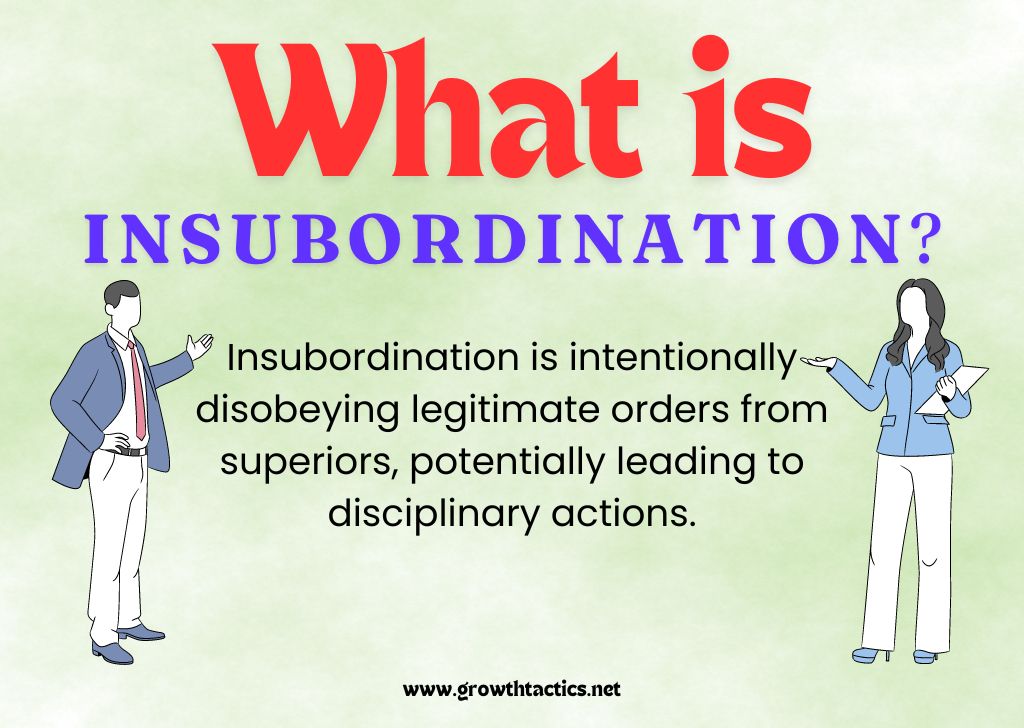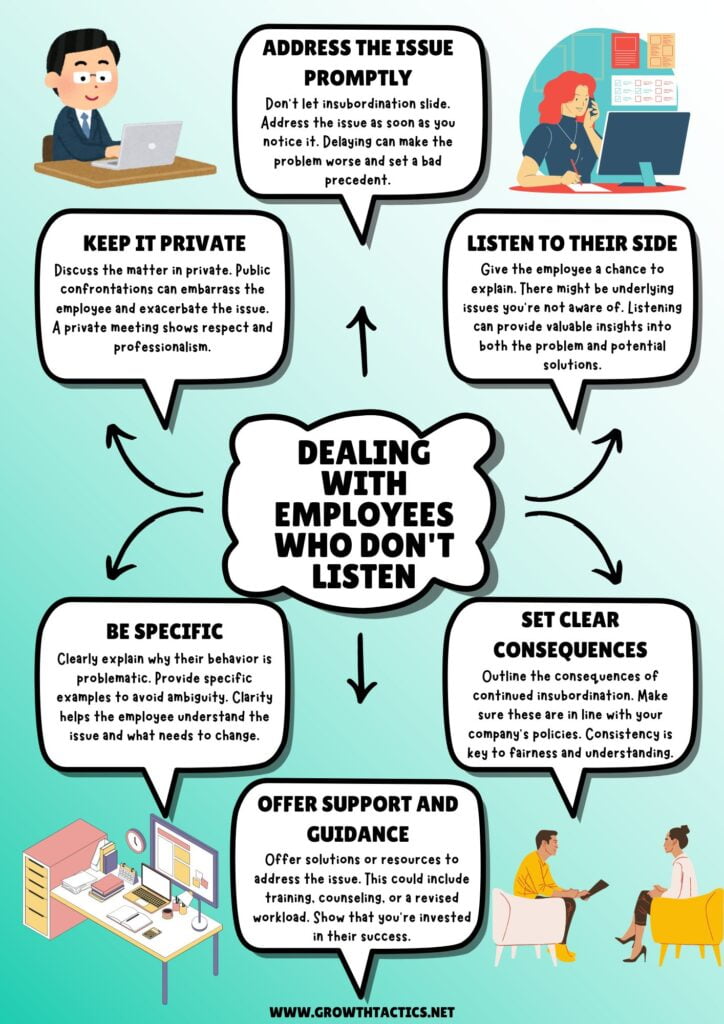Are you at your wits’ end with employees who just won’t listen? Fed up with the dreaded circle of repeating instructions? If you’re nodding along, you’re not alone. Miscommunications can throttle a team’s progress and test your patience.
In our down-to-earth guide, we’ll arm you with straightforward, no-nonsense strategies on how to deal with employees who don’t follow instructions. Say goodbye to frustration and hello to a harmonious workplace. Ready to take back control? Let’s dive in.
Jump To Section
Understanding Insubordination

Insubordination is when an employee refuses to follow instructions. It’s more than just a small mistake. It’s a choice. This can happen for many reasons. Sometimes, it’s a misunderstanding. Other times, it’s outright defiance.
Let’s break it down.
It’s Not Just About Ignoring Orders. When someone is insubordinate, they aren’t just ignoring what you say. They’re choosing to go against it. This decision affects everyone. Projects get delayed. Team morale sinks.
Why Does It Happen? It’s easy to jump to conclusions. But stop and think. Maybe they’re confused. Maybe they don’t see the point. Or maybe, there’s a deeper problem. Stress. Job dissatisfaction. Feeling undervalued. It’s complex.
The Signals Are Clear. Missed deadlines. Eye rolls. Withdrawal. These are not just bad days. They’re signs. Signs that if not addressed, could spiral into bigger issues.
Insubordination is a bump in the road that can turn into a pothole if ignored. Understanding it is the first step towards a solution. Stay tuned as we explore how to spot these behaviors and nip them in the bud, ensuring your team stays on track and thrives.
Identifying Insubordination
Recognizing insubordination early can prevent larger issues in the workplace. Let’s break down the signs even further to help you spot them quickly.
Delayed Responses
Employees usually respond in a timely manner. When they start delaying, it’s a red flag. Delays can disrupt workflow and signal reluctance to comply.
Negative Attitude
Watch out for changes in attitude. Sighs, eye rolls and sarcastic comments are more than bad manners. They’re active forms of resistance that can affect the whole team.
Drop in Quality or Performance
A sudden drop in work quality or performance can signal disengagement. If an employee who used to deliver top-notch work starts turning in subpar results, it’s time to check-in.
Open Defiance
The most obvious sign is open defiance. This includes saying “no” directly or challenging authority in front of others. It disrupts respect and hierarchy in the workplace.
Frequent Complaints
Frequent complaints about the workload, colleagues, or the organization can be subtle signs of insubordination. They often indicate deeper dissatisfaction or a lack of respect for workplace norms.
Identifying these signs early can help you manage insubordination effectively. Addressing these issues promptly ensures a healthier, more productive work environment for everyone.
Preventive Measures
Preventing insubordination starts with effective communication and a positive work environment. Let’s explore how you can proactively address potential issues.
Set Clear Expectations
Be clear about what you expect from your team. Define roles, responsibilities, and deadlines clearly. When expectations are well-defined, there’s less room for confusion or defiance.
Encourage Open Communication
Create a culture where employees feel comfortable sharing their thoughts and concerns. Regular check-ins and an open-door policy can foster trust and prevent conflicts.
Provide Regular Feedback
Don’t wait for annual reviews. Offer feedback consistently. Praise achievements and address concerns early. This not only boosts morale but also corrects small issues before they become big problems.
Offer Support and Resources
Ensure your team has the tools and resources they need to succeed. Lack of support can lead to frustration and resistance. Showing support also boosts feelings of value and belonging among staff.
Lead by Example
Your behavior sets the tone for the entire team. Demonstrate respect, professionalism, and dedication. A positive leader inspires positive actions from their team.
Foster a Positive Work Environment
Celebrate successes. Encourage collaboration and respect among team members. A positive and inclusive work environment reduces stress and increases job satisfaction, cutting down the risk of insubordination.
Preventive measures are key to maintaining harmony in the workplace. By taking these steps, you can create a dynamic team that’s motivated, respectful, and aligned with your organization’s goals.
Dealing with Employees Who Don’t Listen

Handling employees who fail to follow instructions tactfully can turn a challenging situation into an opportunity for growth. Here’s how to approach it effectively.
Address the Issue Promptly
Don’t let insubordination slide. Address the issue as soon as you notice it. Delaying can make the problem worse and set a bad precedent.
Keep it Private
Discuss the matter in private. Public confrontations can embarrass the employee and exacerbate the issue. A private meeting shows respect and professionalism.
Listen to Their Side
Give the employee a chance to explain. There might be underlying issues you’re not aware of. Listening can provide valuable insights into both the problem and potential solutions. Just by hearing their side, an employee may be more likely to listen to your side.
Be Specific
Clearly explain why their behavior is problematic. Provide specific examples to avoid ambiguity. Clarity helps the employee understand the issue and what needs to change.
Set Clear Consequences
Outline the consequences of continued insubordination. Make sure these are in line with your company’s policies. Consistency is key to fairness and understanding.
Offer Support and Guidance
Help them improve. Offer solutions or resources to address the issue. This could include training, counseling, or a revised workload. Show that you’re invested in their success.
Follow Up
Don’t just let the issue drop. Schedule follow-ups to discuss progress. This keeps the lines of communication open and reinforces your commitment to a positive outcome.
Dealing with insubordinate employees requires a balance of firmness and compassion. By taking a structured and empathetic approach, you can guide your team back on track and foster a stronger, more respectful workplace.

Disciplinary Actions and Rehabilitation
When insubordination occurs, disciplinary actions may be necessary. The goal is to correct behavior and support the employee’s return to productivity.
Start with a Warning
Begin with a verbal warning. It’s the first formal step to alert the employee about their conduct. Make sure they understand that this is serious.
Document Everything
Keep records of all incidents and actions taken. Documentation is crucial if the situation escalates or leads to termination. It provides a clear history of the issue.
Escalate Gradually
If the problem persists, escalate the disciplinary actions. This could mean a written warning, suspension, or more intensive interventions. Escalate according to your company’s policy.
Review Company Policy
Ensure that both you and the employee understand the disciplinary policy. Review the policy together if needed. Clarity ensures everyone knows what’s expected.
Consider Suspension
As a next step, a suspension can serve as a strong signal. It provides time for reflection and demonstrates the seriousness of the situation.
Aim for Rehabilitation
Whenever possible, aim to help the employee improve. Offer training, counseling, or mentoring. Show that the goal is to support their development, not just punish.
Know When to Terminate
In cases of severe or repeated insubordination, termination may be necessary. If it comes to this, act decisively and fairly. Follow the company’s protocols to ensure a smooth process.
Disciplinary actions aren’t just about punishment. They’re about guiding the employee back to the right path. With consistent application and a focus on rehabilitation, you can help employees correct their course and contribute positively to the company.
Legal Considerations
Navigating the legal landscape is crucial when managing employee insubordination and disciplinary actions. Here’s what you need to keep in mind.
Understand Employment Laws
Familiarize yourself with federal, state, and local employment laws. These laws cover wrongful termination, discrimination, and workers’ rights. Knowing them helps protect both the company and the employee.
Follow Company Policy
Ensure your actions align with the company’s disciplinary policy. This policy should be legal, fair, and applied consistently to all employees. Deviation can lead to legal challenges.
Maintain Fair Treatment
Treat all employees impartially. Discrimination based on race, gender, age, or any other protected characteristic can have serious legal repercussions. Equal treatment is not just fair; it’s a legal requirement.
Document Carefully
Keep detailed records of the employee’s behavior, your response, and any interactions related to the issue. Documentation provides a defense if legal action is taken against the company.
Provide Due Process
Before taking serious disciplinary actions, give the employee a chance to tell their side of the story. This due process is crucial for fairness and can be a legal requirement.
Seek Legal Advice
When in doubt, consult with a lawyer who specializes in employment law. They can provide guidance specific to your situation and help navigate complex legal waters.
Legal considerations are a critical aspect of handling insubordination. By staying informed and cautious, you can protect both your employees and your company from potential legal issues.
Conclusion
Dealing with insubordination effectively requires being proactive, fair, and consistent. By addressing issues early and adhering to a structured approach, you can maintain a respectful and productive workplace. Remember, the goal is improvement, not just discipline. Make sure to stay informed and seek legal advice when necessary to navigate these challenges confidently.
For more insights and practical tips on leadership and management, check out my other articles. They’re designed to help you become an even more effective manager.


